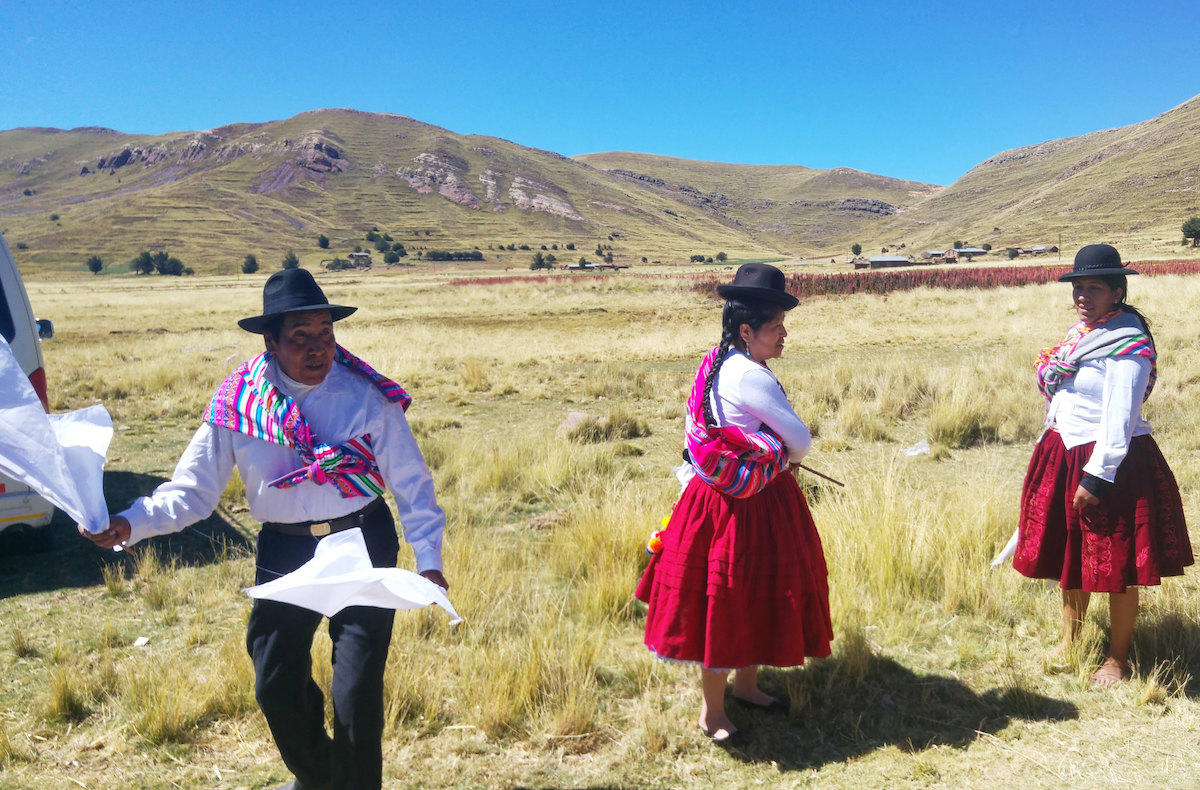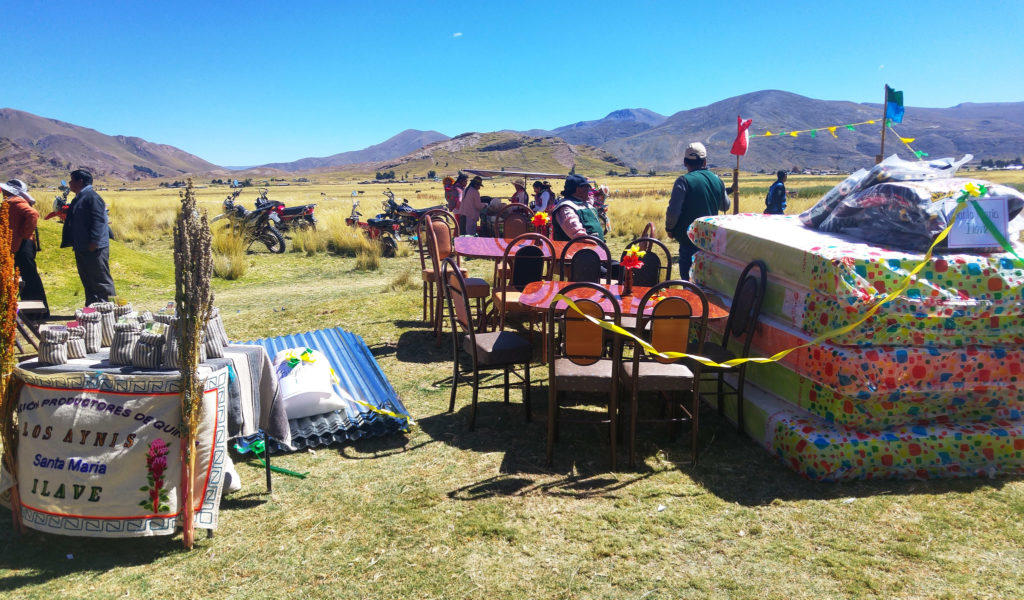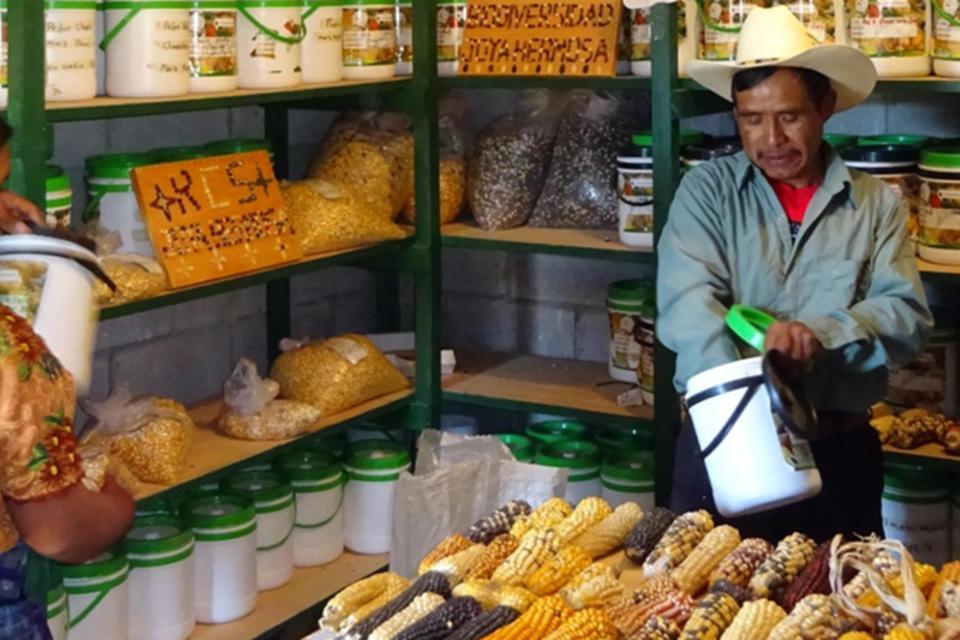Research Articles Better than money? In-kind payments incentivize farmers to conserve agrobiodiversity

An innovative payment scheme for ecosystem services successfully encouraged farmers to cultivate and conserve agrobiodiversity, according to a new study of eight years of implementation in Latin America.
What if you received a new mattress in exchange for planting diverse crops? It may sound unusual, but tangible non-monetary incentives – anything from fertilizer to furniture – may hold significant potential in encouraging farmers to conserve their local agrobiodiversity, which includes a suite of increasingly rare crops and varieties that are often found nowhere else in the world.

Peruvian farmers celebrate successful cultivation of traditional crops, such as the diverse varieties of quinoa on display. Credit: A.Drucker
Peruvian farmers celebrate successful cultivation of traditional crops, such as the diverse varieties of quinoa on display. Credit: A.Drucker
“It turns out that a good conservation farmer is a well-rested conservation farmer,” said Adam Drucker, a researcher at the Alliance of Bioversity International and CIAT.
Drucker and co-author Marleni Ramirez recently assessed eight years of programs that use incentives and competitive tenders in which farmers receive in-kind payments in exchange for cultivating threatened varieties of important crops such as quinoa and maize.

Farmers receive mattresses, farm supplies, and other useful items. Credit: A.Drucker
In their article published in Land Use Policy, Drucker and Ramirez analyzed payments for agrobiodiversity conservation services, or PACS, in four Latin American countries between 2010-2018.
Their conclusion: these schemes are very affordable, attractive to farmers and policymakers, and can successfully conserve crop diversity on farms. The programs have been very well-received in Peru, a megadiverse Andean nation with world-famous cuisine and a long tradition of innovation in cultivation.
Award ceremonies for PACS programs are regularly attended by ministers and other high-level officials, and attract media attention. Due to the success of the programs, PACS are also a part of government policy to conserve biodiversity in the country.
The right incentives
Payment for ecosystem services (PES) is not a new concept. With over 550 PES programs active worldwide, the model offers incentives for beneficiaries to voluntarily commit to sustainably manage land and natural resources. However, high-priority ecosystem services such as water provision have generally eclipsed biodiversity protection.
The article tracks some of the first applications of PES to agrobiodiversity conservation, with schemes encouraging farmers to conserve 130 varieties of crops (including a colorful diversity of quinoa, amaranth, beans, maize and others) in Bolivia, Peru, Guatemala and Ecuador.
Ramirez explained that PES “really fills a gap” by investing in rural communities and holding them collectively responsible. Rather than hand cash to individuals, the process of tenders arranges in-kind payments to groups who bid for conservation contracts.

Drucker and Ramirez visit a farmer’s quinoa field. Credit: A.Drucker
The farmers obtain the necessary seeds and are subject to monitoring visits to provide extension support and verify successful cultivation, after which they receive their award in a handover ceremony. Farmers keep what they grow, minus a small amount of seed that is returned to the project for distribution to other farmers during the following planting season.
“This is a fair and just way to work with communities for participation, equality and social justice,” said Ramirez.
Because the programs use awards that are requested by communities, they create conditions to incentivize extremely high compliance. Monitoring in Peru suggests that five years after intervention and without further incentives during the interim, between 30-50% of participating farmers still maintained the threatened varieties that had been re-introduced. Some 83% of farmers declared willingness to participate in future schemes, even without rewards.
Seed-saving policy
The researchers emphasize that accessing the seeds, which are threatened and rare, is a persistent challenge. While many farmers were willing to participate simply in exchange for seeds, building up a depleted genetic resource base often means years of work.
An important aspect of the PACS model is the prioritization of threatened crop varieties based not only on their diversity value but also their value to farmers for food security, nutrition, climate change adaptation and cultural uses. In what is becoming a common theme in conversations on global biodiversity conservation:
“We can’t protect everything, so we need to decide how to conserve the most that we can,” said Drucker.
Following successful small-scale piloting with an indigenous people’s NGO (UNORCAC), Ecuador has also considered a plan and consulted with the authors. Work with another indigenous people’s NGO in Guatemala (ASOCUCH) has shown the important role community seed bank institutions can play in facilitating seed access and exchange.

Farmers display diverse varieties of quinoa. Credit: A.Drucker
Drucker is confident that the schemes have potential in other countries. Ethiopia, Madagascar and Zambia have all explored PACS at some level. “PACS provide an opportunity for a whole range of institutions including different levels of governments, universities, scientists, national and international NGOs and farmer organizations to partner in implementation,” he said.
Beyond Latin America, Ethiopia and Madagascar are exploring possibilities to apply PACS in protected area buffer zones; and Zambia has looked into its use in the conservation of the wild relatives of crops. At the broader level, the model may be able to lay further groundwork for setting global conservation goals, additional monitoring, market development, and school meal programs.
Drucker and Ramirez conclude that, besides being cost-effective and socially equitable, the PACS platform has shown that many farmers are more than willing to cultivate and conserve threatened crops, and the material reward is only an extra bonus.
“This study reveals that farmers are willing to cultivate traditional and endangered varieties even in absence of any reward. They just want the seeds – and once they have them, they keep sowing them,” said Carlo Fadda, who leads the Alliance’s research area on biodiversity for food and agriculture. “Compared to the $570 billion a year that governments spend to support farmers – mostly at an industrial scale – the investment in PACS is comparatively small and offers a huge return on investment in terms of conservation and livelihoods. I hope Peru’s approach is adopted in many more countries.”
Funding/research partners:
This work was supported by the CGIAR Research Programs on Roots, Tubers and Bananas (RTB); Policies, Institutions and Markets (PIM); and Water, Land and Ecosystems (WLE), and is part of The Alliance/Bioversity’s Economics of Genetic Resources Conservation and Sustainable Use Program of Work.
Further support comes from Peru (Ministry of Environment, Regional Governments of Cusco and Puno, CIRNMA), Ecuador (UNORCAC), Guatemala (ASOCUCH and Universidad del Valle de Guatemala) and Bolivia (PROINPA).

